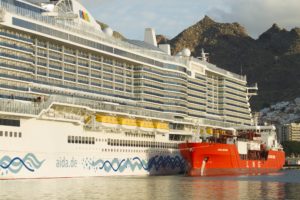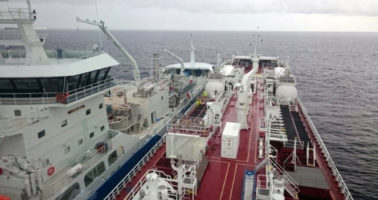Buques bunker de GNL: El monitoreo de la flota de buques bunker de GNL (LNGBV) por parte de FleLNG World Shipping muestra que ahora hay seis buques de este tipo en servicio y otros 12 en revisión de pedidos.
LNG ship-to-ship (STS) bunkering is now in its fifth year, as the 180-m3 LNG bunker vessel (LNGBV) Seagas, a converted small Norwegian ferry, entered into service in Stockholm harbour in 2013 to fuel the passenger/car ferry Viking Grace with 70 tonnes of LNG most days of the week.
Yet until last year Seagas remained the sole practitioner of this method of fuelling LNG-powered ships. It was only in 2017 that the new LNGBV era really began to take hold, when the first three purpose-built LNG fuellers entered service.
The trio are Zeebrugge-based, 5,000-m3 Engie Zeebrugge, 6,500-m3 Cardissa in Rotterdam and 5,800-m3 Coralius, serving in the western Baltic Sea, including the Skagerrak.
These inaugural ships, and the many other LNGBV newbuildings set to follow, are enabling the growing fleet of gas-powered ships to be fuelled in a safer and more timely and efficient manner than is possible with jettyside truck-to-ship LNG transfers. For the large dual-fuel ships on quick port turnaround timetables now entering service, LNGBVs are recognised as the only viable option.
"For the large dual-fuel ships on quick port turnaround timetables now entering service, LNGBVs are recognised as the only viable option"
Last year was also notable for the newbuilding contracts for four 7,500-m3 coastal LNG carriers, comprising two for Korea Line and two for Stolt-Nielsen Gas, and all scheduled for 2019 completions. Although only one of the Korea Line ships has been definitively earmarked for LNGBV duties, all four are set to be provided with the ability to carry out STS fuelling operations.
The 2017 newbuilding contracts complemented an order for a new LNGBV placed in 2016. This is the 7,500-m3 LNGBV Kairos that Korea’s Hyundai Mipo yard is building for Babcock Schulte Energy, a Bernhard Schulte Shipmanagement/Babcock International joint venture. Kairos is due for commissioning in September 2018 and is profiled on page 22 of this issue.
With Klaipeda in Lithuania serving as its home port, Kairos will be chartered by Blue LNG, a Nauticor/Klaipedos Nafta joint venture. Clients will include Gothia Tanker Alliance, the Swedish operator of a fleet of regional North/Baltic Sea chemical/product distribution tankers that run on LNG.
Brisk start to 2018
As the new year commenced, LNGBV fleet developments continued apace. During the first five weeks of 2018 an LNGBV almost three times the size of any such vessel yet built was ordered, while the first Spanish LNG STS fuelling operation, utilising a newly converted bunker barge, was carried out in Bilbao.
LNG bunker vessel fleet
Name (or owner) Delivery Capacity
Date (m3)
- Seagas 2013 180
- Engie Zeebrugge 2017 5,000
- Cardissa 2017 6,500
- Coralius 2017 5,800
- Oizmendi 2018 600
- Coral Methane 2018 7,500
- Kairos 2018 7,500
- Clean Jacksonville 2018 2,200
- FlexFueler1 2018 760
- Stolt-Nielsen Gas 2019 7,500
- Stolt-Nielsen Gas 2019 7,500
- Korea Line 2019 7,500
- Korea Line 2019 7,500
- Victrol/CFT 2019 3,000
- Total/MOL 2020 18,600
- Q-LNG 2020 4,000
- FueLNG 2020 7,500
- CLS Japan 2020 3,500
The Bilbao barge is Oizmendi, originally a 3,200-dwt pollution control vessel but now converted to a multipurpose bunkering station. In addition to its underdeck oil tanks, Oizmendi has been provided with two 300-m3, deck-mounted, Type C LNG tanks.
The Spanish bunker vessel carried out its first gas-fuelling STS operation on 3 February 2018 when it transferred 40 tonnes of LNG to the cement carrier Ireland. Following this transfer, Oizmendi was relocated to Huelva in southern Spain where it is being utilised as an oil and LNG fueller.
The LNGBV newbuilding that is three times bigger than any other such vessel is the 18,600-m3 gas tanker Total Marine Fuels Global Solutions and Mitsui OSK Lines contracted at the Hudong-Zhonghua yard in China for delivery in 2020.
Total has won the contract to supply the 300,000 tonnes per annum of LNG needed to power the fleet of nine new 22,000 TEU dual-fuel container ships ordered recently by the French liner operator CMA CGM. It will utilise its Hudong newbuilding to fuel the box ships, each of which will have an LNG bunker tank of 18,600 m3 in capacity.
Both the cargo tanks on the bunker vessel and the bunker tank on each of the CMA CGM container ships are being built to the GTT Mark III membrane design. As a result, the Total bunkering operations will involve LNG bunker transfers at atmospheric pressure. All other STS LNG bunkering operations carried out to date have been from one IMO Type C pressure vessel tank to another.
More deliveries
Another ship conversion project has yielded a ‘new’ LNGBV. Anthony Veder’s 7,500-m3 LNG carrier Coral Methane is currently at the Remontowa yard in Poland to be provided with a fuelling capability through the integration of specific bunkering equipment into the cargo-handling arrangements. Shell is chartering the vessels to carry out STS fuelling operations in the southern part of the North Sea and the Mediterranean.

Recent modification work has transformed the coastal LNG carrier Coral Methane into an LNG bunker vessel
Also set for 2018 deliveries are 2,200-m3 Clean Jacksonville, a non-propelled vessel which will be North America’s first seagoing LNG bunker barge, and Titan LNG’s FlexFueler1 pontoon. The latter newbuilding has been designed to fuel gas-powered inland waterway and small seagoing vessels throughout the Antwerp-Rotterdam-Amsterdam region and will initially be positioned in Amsterdam. FlexFueler1 will be provided with two 380-m3 LNG tanks initially, but a further two tanks could be installed should market demand warrant it.
Clean Jacksonville will be stationed in the Florida port of Jacksonville and TOTE Maritime’s two new 3,100-TEU Marlin-class, LNG-powered container ships that sail regularly to Puerto Rico will be the anchor customers of the vessel’s cryogenic fuelling services. Clean Jacksonville has a GTT Mark III cargo tank and is the first LNGBV to feature a membrane containment system.
Shell-centred
Shell, operator of Cardissa and charterer of Coral Methane, is set to have its LNGBV fleet further augmented. Long-term charters with the energy major have supported orders for a 3,000-m3 LNG bunker barge being built for a Victrol/CFT joint venture and a 4,000-m3 barge that will be an integral part of an articulated tug/barge (ATB) under construction for Quality LNG Transport (Q-LNG).
The Victrol/CFT LNGBV will be stationed in Rotterdam and used to fuel inland waterway vessels while Shell will employ the Q-LNG ATB to supply LNG as marine fuel along the southeastern US coast. Most notable among the ATB’s customers will be the new generation of LNG-powered cruise ships now under construction that will be homeported in Florida. Two Carnival Cruise ships will be the LNGBV’s foundation customers.
Shell is also partnering with Keppel Offshore & Marine in FueLNG, a joint venture which ordered, in June 2018, what will be Singapore’s first LNGBV. The 7,500-m3 gas carrier is under construction at the Keppel Singmarine yard at Nantong in China, with a target completion date of Q3 2020.
Although additional LNGBV newbuilding contracts appear to be imminent, the last ship on our fleet list as a confirmed order is a 3,500-m3 fueller contracted by Central LNG Shipping Japan Corp at Kawasaki Heavy Industries in July 2018. To be Japan’s first LNGBV, the vessel will serve LNG-powered ships visiting the country’s central Chubu region around Nagoya and Ise Bay.
The four participants in the CLS joint venture are K Line, Chubu Electric Power, Toyota Tsusho Corp and NYK Line.

